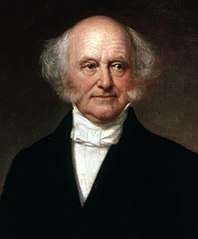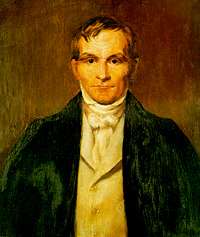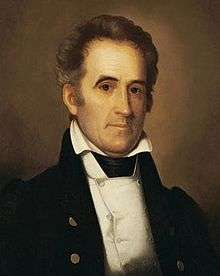1832 Democratic National Convention
The 1832 Democratic National Convention was held from May 21 to May 23, 1832, in Baltimore, Maryland.[1] In the first presidential nominating convention ever held by the Democratic Party, incumbent President Andrew Jackson was nominated for a second term, while former Secretary of State Martin Van Buren was nominated for vice president.
| 1832 presidential election | |
  Nominees Jackson and Van Buren | |
| Convention | |
|---|---|
| Date(s) | May 21–23, 1832 |
| City | Baltimore, Maryland |
| Venue | "The Athenaeum", (first), St. Paul and East Lexington Streets Warfield's Church (First Universalist) |
| Candidates | |
| Presidential nominee | Andrew Jackson of Tennessee |
| Vice presidential nominee | Martin Van Buren of New York |
| Voting | |
| Total delegates | 283 |
| Results (President) | Jackson (TN): 283 (100%) |
| Results (Vice President) | Van Buren (NY): 208 (73.5%) Barbour (VA): 49 (17.3%) Johnson (KY): 26 (9.2%) |
The Anti-Masonic Party and the National Republican Party had held the first presidential nominating conventions in 1831, and Jackson's "Kitchen Cabinet" helped organize a Democratic convention in 1832. As party leaders assumed that Jackson would be nominated for president, the primary purpose of holding the convention was to nominate a candidate for vice president. Jackson needed a new running mate because he had fallen out with Vice President John C. Calhoun over the Petticoat affair and the Nullification Crisis.[2]
The convention, which was presided over by Governor Robert Lucas, hosted delegates from every state except Missouri. Jackson won the presidential nomination unanimously.[3] With Jackson's strong endorsement, Van Buren won the vice presidential nomination by a wide margin, defeating former Congressman Philip Pendleton Barbour of Virginia and Congressman Richard Mentor Johnson of Kentucky.[4] The Democratic ticket of Jackson and Van Buren went on to win the 1832 presidential election.
Background
In the summer of 1822, "Richmond Junto" leader Thomas Ritchie of Virginia began raising the idea of a national convention to resolve the issue of nomination; ultimately, the Congressional nominating caucus was appealed to by the devotees of Treasury Secretary William H. Crawford's candidacy.[5] Following that defeat in the election of 1824, early in 1827, Van Buren privately made the argument to Richie for an exclusive national convention of Republicans to ensure Jackson's nomination.[5] However, it did not immediately come to fruition while state conventions and legislatures took up Jackson as their presidential candidate for the election of 1828 with Vice President John C. Calhoun as his running mate. Such a type of national convention would occur after the election.
Calhoun soon became politically estranged from President Jackson, due in part to an 1830 letter written by Crawford stating that Calhoun, as Secretary of War under President James Monroe, pushed for a reprimand of then-General Jackson for his actions in the 1818 invasion of Florida. The Petticoat affair in which Calhoun's wife, Floride, was a central figure further alienated Jackson from the vice president and his supporters. The final blow to the relationship came in January 1832, when Calhoun, as President of the Senate, sank Van Buren's nomination as Minister to Great Britain by casting a tie-breaking vote in the United States Senate.[6] Consequently, Calhoun was replaced as the party's 1832 vice presidential nominee by Van Buren.[7] Later that year, on December 28, he resigned as Vice President, after having been elected to the U.S. Senate.[8] There he continued to be a proponent of the doctrine of nullification in opposition to Jackson.
The proposal for the convention began with members of Jackson's "Kitchen Cabinet", his coterie of informal advisers and confidants. Major William Berkeley Lewis wrote on May 25, 1831, to Amos Kendall, who was then in New Hampshire. He proposed that the New Hampshire legislature call for a national gathering of Republican supporters of the Jackson administration to nominate a candidate for the vice presidency, and asked Kendall to pass the idea to Isaac Hill.[9] After the New Hampshire legislature issued the call for a general convention, the Washingoton Globe, the principal Jacksonian newspaper,[lower-alpha 1] seconded the recommendation on July 6, 1831:
The recommendation of a Convention at Baltimore to nominate a candidate for the Vice-Presidency deserves a serious consideration. It is probably the best plan which can be adopted to produce entire unanimity in the Republican party, and secure its lasting ascendancy.[9]
Lewis later recalled warning former Secretary of War and delegate John Eaton the day before the convention not to vote for anyone there except Van Buren unless he was prepared to "quarrel with the General [Jackson]."[9]
Proceedings
The convention was called to order by Frederick A. Sumner of New Hampshire, who said of the origins and purpose of the convention:
Gentlemen—The proposition for calling a general convention of delegates, to act on the nomination of a candidate for president, and to select a suitable candidate for vice-president of the United States, originated in the state of New Hampshire, by the friends of democracy in that state; and it appears that the proposition, although opposed by the enemies of the democratic party, has found favor in nearly and perhaps all the States of the Union ... The object of the representatives of the people of New Hampshire who called this convention was not to impose on the people as candidate for either of the two offices in this government, any local favorite; but to concentrate the opinion of all the states ... They believed that the example of this convention would operate favorably in future elections; that the people would be disposed after seeing the good effects of this convention in conciliating the different and distant sections of the country, to continue this mode of nomination.[10]
Delegates from all states except Missouri were present. Governor Robert Lucas of Ohio served as the chairman and convention president. Peter Vivian Daniel, James Fenner, John M. Barclay, and Augustin Smith Clayton were chosen as convention vice presidents. John Adams Dix was appointed secretary at the first meeting, with other additional secretaries thereafter. A resolution was passed by the convention requiring two-thirds majority support of the delegates for a nomination.
An address by the Republican delegates of New York gave a history of previous national political activity in the United States. They denounced the National Republicans as Federalists under a new designation and they denounced the Nullifiers while they declared that their own party held the middle ground between the positions of the other two. The address described what they claimed were political similarities between Andrew Jackson and Thomas Jefferson and it defended the policies of Jackson's administration. It characterized Van Buren as a strict constructionist and welcomed his nomination.
The convention concluded by adopting a resolution calling for an address or report from the delegations to their constituents.
Presidential nomination
Presidential candidate
Vice Presidential nomination
Vice Presidential candidates

Martin Van Buren was nominated for vice president on the first ballot after receiving 208 votes, well over the two-thirds majority required. Altogether, 283 of the 334 registered delegates voted.[7]
| 1832 Democratic National Convention vice presidential nomination vote[11] | ||
|---|---|---|
| Candidate (home state) | Votes | Percentage |
| Martin Van Buren (New York) | 208 | 73.50% |
| Philip Pendleton Barbour (Virginia) | 49 | 17.31% |
| Richard Mentor Johnson (Kentucky) | 26 | 9.19% |
| Totals | 283 | 100.00% |
| Necessary | 189 | >66.66% |
General election
Andrew Jackson and Martin Van Buren defeated their main competitors, Henry Clay and John Sergeant of the National Republican Party, by a large electoral vote margin in the election of 1832.[12]
See also
Notes
- The Globe was established in 1830 in Washington, D.C., with Amos Kendall's influence, and was edited by Francis Preston Blair. It supplanted General Duff Green's United States Telegraph, which was associated with John Calhoun.
References
- "Democratic National Political Conventions 1832-2008 (Library of Congress)". www.loc.gov. Retrieved 2020-01-02.
- Cheathem, Mark Renfred (2008). Jacksonian and Antebellum Age: People and Perspectives. ABC-CLIO. ISBN 978-1-59884-017-9.
- "United States presidential election of 1836 | United States government". Encyclopedia Britannica. Retrieved 2020-01-02.
- Belko, William S. (2016-04-30). Philip Pendleton Barbour in Jacksonian America: An Old Republican in King Andrew’s Court. University of Alabama Press. ISBN 978-0-8173-1906-9.
- Rutland, Robert Allen (1995) [First published 1979, Louisiana State University Press]. The Democrats: From Jefferson to Clinton (Updated ed.). Columbia, Missouri: University of Missouri Press. pp. 47, 56. ISBN 0-8262-1034-1.
- "Martin Van Buren". whitehouse.gov. Washington, D.C.: The White House. Retrieved October 9, 2019.
- Haynes, Stan M. (2012). The First American Political Conventions: Transforming Presidential Nominations, 1832–1872. Jefferson, North Carolina: McFarland & Company. pp. 34–36. ISBN 978-0-7864-6892-8.
- "Calhoun resigns vice presidency". history.com. A&E Television Networks. July 28, 2019 [Originally published February 9, 2010]. Retrieved October 9, 2019.
- Parton, James (1860). Life of Andrew Jackson. 3. New York, New York: Mason Brothers. pp. 382–385, 421. Retrieved October 9, 2019 – via Google Books, digitized August 2, 2006.
- Niles, Hezekiah, ed. (May 26, 1832). "Jackson General Convention". Niles' Weekly Register. Volume 42. Baltimore, Maryland: H. Niles. pp. 234–236. Retrieved October 9, 2019 – via HathiTrust Digital Library.
- "US Vice President – D Convention (May 1832)". ourcampaigns.com. Retrieved October 9, 2019.
- "U. S. Electoral College". www.archives.gov.
External links
- Summary of the Proceedings of a Convention of Republican Delegates, from the Several States in the Union, for the Purpose of Nominating a Candidate for the Office of Vice-President of the United States; Held at Baltimore, in the State of Maryland, May, 1832: With an Address, to the Republicans of the State of New-York, Prepared by their Delegates, in Compliance with the Recommendation of Said Convention, Democratic National Convention (1832). Albany, New York: Packard and Van Benhuysen.
| Preceded by - |
Democratic National Conventions | Succeeded by 1835 Baltimore, Maryland |



